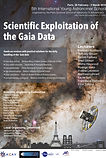
Paris, 26 February - 2 March 2018
5th International Young Astronomer School
organized by the Paris Doctoral School of Astronomy & Astrophysics
Lecturers
Piercarlo Bonifacio, Paris Observatory
Anthony Brown, Leiden Observatory
Benoit Famaey, Strasbourg Observatory
Brad Gibson, University of Hull
Misha Haywood, Paris Observatory
Rodrigo Ibata, Strasbourg Observatory
Yveline Lebreton, Paris Observatory
Matthew Lehnert, Institut d'Astrohysique de Paris
Xavier Luri, Barcelona University
Francesca Matteucci, Trieste University
Eline Tolstoy, Kapteyn Astronomical Institut
ESO/S. Guisard ESA/ATG Medialab
Scientific case
The first Gaia catalogue, published in September 2016, gave to astronomers a flavor of the outstanding quality and scope of the Gaia data, but its full scale will come with the Spring 2018 data release. It will contain parallaxes and proper motions for the entire catalogue (more than 1 billion stars), and radial velocities for 5 millions of them. The scientific community, and the PHD students and post-docs in particular, will then meet two challenges: handling this huge data set, and tackle the key scientific questions of what constitute the heart of the Gaia mission, the study of the Milky Way galaxy.
On practically all aspects of stellar populations and Galactic evolution, the exploitation of the Gaia data is expected to lead to scientific breakthroughs: measurement of the rotation curve, the gravitational potential, the structure of our Galaxy, its mass growth, etc., and therefore represents a huge interest for the community.
The aim of the school is twofold:
-
To have the best experts in their field present the key questions on stellar populations structure, chemical and dynamical evolution of the Milky Way, through both modeling aspects and direct exploration of the data to students and post-docs.
-
To bring very practical answers to the needs of the young astronomers to do their daily science with the Gaia data (handling of the Gaia archive, limits of the data, rigorous statistical handling of the errors, correlations and completeness of the catalogue, familiarity with the available codes to compute various parameters of interest for Galactic science (velocities, orbits, age, etc.).
The content of the Gaia DR2 is described here
Local Organizing Committee
Jacques Le Bourlot
Jacqueline Plancy
Stéphane Thomas
Paola Di Matteo
Misha Haywood
Scientific Organizing Committee
Frédéric Arenou
Anthony Brown
Piercarlo Bonifacio
Paola Di Matteo
Francesca Figueras
Brad Gibson
Misha Haywood (Chair)
David Katz
Jacques Le Bourlot
Elena Pancino
Noel Robichon



Sponsors
A high-resolution version of the poster is available here








